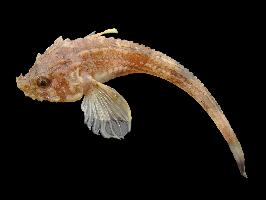
Poids et mesures
| Longueur | de 12 à 15 cm |
|---|
Description de l'animal
The Hooknose, scientifically known as Agonus cataphractus, is a distinctive species of fish that dwells in the chilly waters of the North Atlantic Ocean. This intriguing creature is a member of the Agonidae family, often referred to as poachers due to their unique appearance and bottom-dwelling habits. The Hooknose is particularly notable for its armored body and peculiar facial structure, which contribute to its common name and make it an interesting subject of study among marine biologists and enthusiasts alike.One of the most striking features of the Hooknose is its body, which is encased in bony plates. These plates serve as a formidable armor, protecting the fish from predators and the abrasive nature of the seabed. The body of the Hooknose is elongated and somewhat cylindrical, tapering towards the tail. It possesses a dull, mottled coloration, typically a blend of brown, grey, and green hues, which serves as excellent camouflage against the seabed, making it a master of disguise in its natural habitat.
The head of the Hooknose is characterized by its prominent snout, from which it derives its common name. The snout is long and curved, resembling a hook, and is used by the fish to forage in the sediment for food. Its mouth is small and positioned underneath the snout, adapted for sucking up prey from the ocean floor. The eyes of the Hooknose are relatively small and are positioned on the top of its head, allowing it to keep a lookout for predators while remaining mostly buried in the substrate.
In terms of size, the Hooknose is relatively small, usually reaching lengths of up to 20 centimeters, though some specimens may grow slightly larger. Its body is covered with small, spiny scales that add an extra layer of protection. Despite its armored body, the Hooknose is known for its slow movements, relying more on stealth and camouflage than speed to avoid predators and capture prey.
The diet of the Hooknose primarily consists of small invertebrates, such as crustaceans, mollusks, and worms, which it finds in the sediment. Its feeding habits play a crucial role in the benthic ecosystem, contributing to the cycling of nutrients and the maintenance of the ocean floor's health.
The Hooknose is a solitary creature, rarely found in groups, and tends to lead a sedentary lifestyle, spending much of its time buried in the sediment or hiding among rocks and seaweed. During the breeding season, however, males and females come together to spawn. The eggs are fertilized externally and are often attached to objects on the ocean floor, where they remain until hatching.
In conclusion, the Hooknose (Agonus cataphractus) is a fascinating marine species, notable for its armored body, unique snout, and benthic lifestyle. Despite its small size, it plays a significant role in its ecosystem and continues to captivate those who study and observe the rich diversity of life in the world's oceans.
Nouvelles photos d'animaux
Top 10 des animaux
- Dolphin gull (Leucophaeus scoresbii)
- Diana monkey (Cercopithecus diana)
- Moustached guenon (Cercopithecus cephus)
- Galápagos tortoise (Geochelone nigra complex)
- Russian tortoise (Testudo horsfieldii)
- Stone loach (Barbatula barbatula)
- Japanese macaque (Macaca fuscata)
- Common flying dragon (Draco volans)
- Greek tortoise (Testudo graeca)
- Vendace (Coregonus albula)